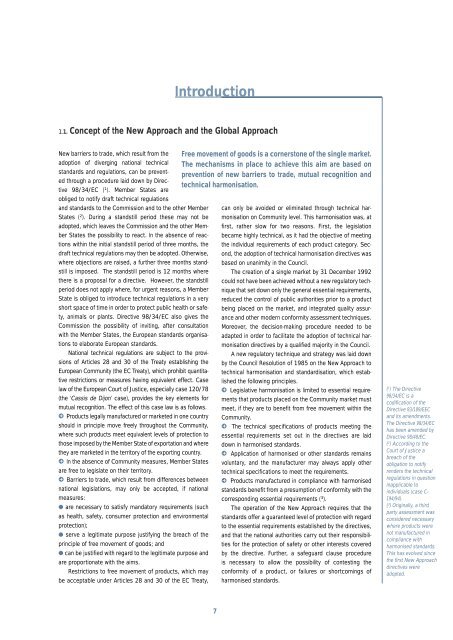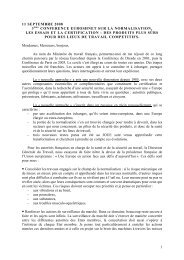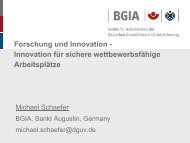Guide to the implementation of directives based on the New ...
Guide to the implementation of directives based on the New ...
Guide to the implementation of directives based on the New ...
You also want an ePaper? Increase the reach of your titles
YUMPU automatically turns print PDFs into web optimized ePapers that Google loves.
Introducti<strong>on</strong><br />
1.1. C<strong>on</strong>cept <str<strong>on</strong>g>of</str<strong>on</strong>g> <str<strong>on</strong>g>the</str<strong>on</strong>g> <strong>New</strong> Approach and <str<strong>on</strong>g>the</str<strong>on</strong>g> Global Approach<br />
<strong>New</strong> barriers <str<strong>on</strong>g>to</str<strong>on</strong>g> trade, which result from <str<strong>on</strong>g>the</str<strong>on</strong>g> Free movement <str<strong>on</strong>g>of</str<strong>on</strong>g> goods is a corners<str<strong>on</strong>g>to</str<strong>on</strong>g>ne <str<strong>on</strong>g>of</str<strong>on</strong>g> <str<strong>on</strong>g>the</str<strong>on</strong>g> single market.<br />
adopti<strong>on</strong> <str<strong>on</strong>g>of</str<strong>on</strong>g> diverging nati<strong>on</strong>al technical The mechanisms in place <str<strong>on</strong>g>to</str<strong>on</strong>g> achieve this aim are <str<strong>on</strong>g>based</str<strong>on</strong>g> <strong>on</strong><br />
standards and regulati<strong>on</strong>s, can be prevented<br />
through a procedure laid down by Direc-<br />
preventi<strong>on</strong> <str<strong>on</strong>g>of</str<strong>on</strong>g> new barriers <str<strong>on</strong>g>to</str<strong>on</strong>g> trade, mutual recogniti<strong>on</strong> and<br />
technical harm<strong>on</strong>isati<strong>on</strong>.<br />
tive 98/34/EC ( 1 ). Member States are<br />
obliged <str<strong>on</strong>g>to</str<strong>on</strong>g> notify draft technical regulati<strong>on</strong>s<br />
and standards <str<strong>on</strong>g>to</str<strong>on</strong>g> <str<strong>on</strong>g>the</str<strong>on</strong>g> Commissi<strong>on</strong> and <str<strong>on</strong>g>to</str<strong>on</strong>g> <str<strong>on</strong>g>the</str<strong>on</strong>g> o<str<strong>on</strong>g>the</str<strong>on</strong>g>r Member can <strong>on</strong>ly be avoided or eliminated through technical harm<strong>on</strong>isati<strong>on</strong><br />
<strong>on</strong> Community level. This harm<strong>on</strong>isati<strong>on</strong> was, at<br />
States ( 2 ). During a standstill period <str<strong>on</strong>g>the</str<strong>on</strong>g>se may not be<br />
adopted, which leaves <str<strong>on</strong>g>the</str<strong>on</strong>g> Commissi<strong>on</strong> and <str<strong>on</strong>g>the</str<strong>on</strong>g> o<str<strong>on</strong>g>the</str<strong>on</strong>g>r Member<br />
States <str<strong>on</strong>g>the</str<strong>on</strong>g> possibility <str<strong>on</strong>g>to</str<strong>on</strong>g> react. In <str<strong>on</strong>g>the</str<strong>on</strong>g> absence <str<strong>on</strong>g>of</str<strong>on</strong>g> reac-<br />
became highly technical, as it had <str<strong>on</strong>g>the</str<strong>on</strong>g> objective <str<strong>on</strong>g>of</str<strong>on</strong>g> meeting<br />
first, ra<str<strong>on</strong>g>the</str<strong>on</strong>g>r slow for two reas<strong>on</strong>s. First, <str<strong>on</strong>g>the</str<strong>on</strong>g> legislati<strong>on</strong><br />
ti<strong>on</strong>s within <str<strong>on</strong>g>the</str<strong>on</strong>g> initial standstill period <str<strong>on</strong>g>of</str<strong>on</strong>g> three m<strong>on</strong>ths, <str<strong>on</strong>g>the</str<strong>on</strong>g> <str<strong>on</strong>g>the</str<strong>on</strong>g> individual requirements <str<strong>on</strong>g>of</str<strong>on</strong>g> each product category. Sec<strong>on</strong>d,<br />
<str<strong>on</strong>g>the</str<strong>on</strong>g> adopti<strong>on</strong> <str<strong>on</strong>g>of</str<strong>on</strong>g> technical harm<strong>on</strong>isati<strong>on</strong> <str<strong>on</strong>g>directives</str<strong>on</strong>g> was<br />
draft technical regulati<strong>on</strong>s may <str<strong>on</strong>g>the</str<strong>on</strong>g>n be adopted. O<str<strong>on</strong>g>the</str<strong>on</strong>g>rwise,<br />
where objecti<strong>on</strong>s are raised, a fur<str<strong>on</strong>g>the</str<strong>on</strong>g>r three m<strong>on</strong>ths standstill<br />
is imposed. The standstill period is 12 m<strong>on</strong>ths where The creati<strong>on</strong> <str<strong>on</strong>g>of</str<strong>on</strong>g> a single market by 31 December 1992<br />
<str<strong>on</strong>g>based</str<strong>on</strong>g> <strong>on</strong> unanimity in <str<strong>on</strong>g>the</str<strong>on</strong>g> Council.<br />
<str<strong>on</strong>g>the</str<strong>on</strong>g>re is a proposal for a directive. However, <str<strong>on</strong>g>the</str<strong>on</strong>g> standstill could not have been achieved without a new regula<str<strong>on</strong>g>to</str<strong>on</strong>g>ry technique<br />
that set down <strong>on</strong>ly <str<strong>on</strong>g>the</str<strong>on</strong>g> general essential requirements,<br />
period does not apply where, for urgent reas<strong>on</strong>s, a Member<br />
State is obliged <str<strong>on</strong>g>to</str<strong>on</strong>g> introduce technical regulati<strong>on</strong>s in a very reduced <str<strong>on</strong>g>the</str<strong>on</strong>g> c<strong>on</strong>trol <str<strong>on</strong>g>of</str<strong>on</strong>g> public authorities prior <str<strong>on</strong>g>to</str<strong>on</strong>g> a product<br />
short space <str<strong>on</strong>g>of</str<strong>on</strong>g> time in order <str<strong>on</strong>g>to</str<strong>on</strong>g> protect public health or safety,<br />
animals or plants. Directive 98/34/EC also gives <str<strong>on</strong>g>the</str<strong>on</strong>g> ance and o<str<strong>on</strong>g>the</str<strong>on</strong>g>r modern c<strong>on</strong>formity assessment techniques.<br />
being placed <strong>on</strong> <str<strong>on</strong>g>the</str<strong>on</strong>g> market, and integrated quality assur-<br />
Commissi<strong>on</strong> <str<strong>on</strong>g>the</str<strong>on</strong>g> possibility <str<strong>on</strong>g>of</str<strong>on</strong>g> inviting, after c<strong>on</strong>sultati<strong>on</strong> Moreover, <str<strong>on</strong>g>the</str<strong>on</strong>g> decisi<strong>on</strong>-making procedure needed <str<strong>on</strong>g>to</str<strong>on</strong>g> be<br />
with <str<strong>on</strong>g>the</str<strong>on</strong>g> Member States, <str<strong>on</strong>g>the</str<strong>on</strong>g> European standards organisati<strong>on</strong>s<br />
<str<strong>on</strong>g>to</str<strong>on</strong>g> elaborate European standards.<br />
m<strong>on</strong>isati<strong>on</strong> <str<strong>on</strong>g>directives</str<strong>on</strong>g> by a qualified majority in <str<strong>on</strong>g>the</str<strong>on</strong>g> Council.<br />
adapted in order <str<strong>on</strong>g>to</str<strong>on</strong>g> facilitate <str<strong>on</strong>g>the</str<strong>on</strong>g> adopti<strong>on</strong> <str<strong>on</strong>g>of</str<strong>on</strong>g> technical har-<br />
Nati<strong>on</strong>al technical regulati<strong>on</strong>s are subject <str<strong>on</strong>g>to</str<strong>on</strong>g> <str<strong>on</strong>g>the</str<strong>on</strong>g> provisi<strong>on</strong>s<br />
<str<strong>on</strong>g>of</str<strong>on</strong>g> Articles 28 and 30 <str<strong>on</strong>g>of</str<strong>on</strong>g> <str<strong>on</strong>g>the</str<strong>on</strong>g> Treaty establishing <str<strong>on</strong>g>the</str<strong>on</strong>g> by <str<strong>on</strong>g>the</str<strong>on</strong>g> Council Resoluti<strong>on</strong> <str<strong>on</strong>g>of</str<strong>on</strong>g> 1985 <strong>on</strong> <str<strong>on</strong>g>the</str<strong>on</strong>g> <strong>New</strong> Approach <str<strong>on</strong>g>to</str<strong>on</strong>g><br />
A new regula<str<strong>on</strong>g>to</str<strong>on</strong>g>ry technique and strategy was laid down<br />
European Community (<str<strong>on</strong>g>the</str<strong>on</strong>g> EC Treaty), which prohibit quantitative<br />
restricti<strong>on</strong>s or measures having equivalent effect. Case lished <str<strong>on</strong>g>the</str<strong>on</strong>g> following principles.<br />
technical harm<strong>on</strong>isati<strong>on</strong> and standardisati<strong>on</strong>, which estab-<br />
law <str<strong>on</strong>g>of</str<strong>on</strong>g> <str<strong>on</strong>g>the</str<strong>on</strong>g> European Court <str<strong>on</strong>g>of</str<strong>on</strong>g> Justice, especially case 120/78 * Legislative harm<strong>on</strong>isati<strong>on</strong> is limited <str<strong>on</strong>g>to</str<strong>on</strong>g> essential requirements<br />
that products placed <strong>on</strong> <str<strong>on</strong>g>the</str<strong>on</strong>g> Community market must<br />
(<str<strong>on</strong>g>the</str<strong>on</strong>g> ‘Cassis de Dij<strong>on</strong>’ case), provides <str<strong>on</strong>g>the</str<strong>on</strong>g> key elements for<br />
mutual recogniti<strong>on</strong>. The effect <str<strong>on</strong>g>of</str<strong>on</strong>g> this case law is as follows. meet, if <str<strong>on</strong>g>the</str<strong>on</strong>g>y are <str<strong>on</strong>g>to</str<strong>on</strong>g> benefit from free movement within <str<strong>on</strong>g>the</str<strong>on</strong>g><br />
* Products legally manufactured or marketed in <strong>on</strong>e country Community.<br />
should in principle move freely throughout <str<strong>on</strong>g>the</str<strong>on</strong>g> Community, * The technical specificati<strong>on</strong>s <str<strong>on</strong>g>of</str<strong>on</strong>g> products meeting <str<strong>on</strong>g>the</str<strong>on</strong>g><br />
where such products meet equivalent levels <str<strong>on</strong>g>of</str<strong>on</strong>g> protecti<strong>on</strong> <str<strong>on</strong>g>to</str<strong>on</strong>g> essential requirements set out in <str<strong>on</strong>g>the</str<strong>on</strong>g> <str<strong>on</strong>g>directives</str<strong>on</strong>g> are laid<br />
those imposed by <str<strong>on</strong>g>the</str<strong>on</strong>g> Member State <str<strong>on</strong>g>of</str<strong>on</strong>g> exportati<strong>on</strong> and where down in harm<strong>on</strong>ised standards.<br />
<str<strong>on</strong>g>the</str<strong>on</strong>g>y are marketed in <str<strong>on</strong>g>the</str<strong>on</strong>g> terri<str<strong>on</strong>g>to</str<strong>on</strong>g>ry <str<strong>on</strong>g>of</str<strong>on</strong>g> <str<strong>on</strong>g>the</str<strong>on</strong>g> exporting country. * Applicati<strong>on</strong> <str<strong>on</strong>g>of</str<strong>on</strong>g> harm<strong>on</strong>ised or o<str<strong>on</strong>g>the</str<strong>on</strong>g>r standards remains<br />
* In <str<strong>on</strong>g>the</str<strong>on</strong>g> absence <str<strong>on</strong>g>of</str<strong>on</strong>g> Community measures, Member States voluntary, and <str<strong>on</strong>g>the</str<strong>on</strong>g> manufacturer may always apply o<str<strong>on</strong>g>the</str<strong>on</strong>g>r<br />
are free <str<strong>on</strong>g>to</str<strong>on</strong>g> legislate <strong>on</strong> <str<strong>on</strong>g>the</str<strong>on</strong>g>ir terri<str<strong>on</strong>g>to</str<strong>on</strong>g>ry.<br />
technical specificati<strong>on</strong>s <str<strong>on</strong>g>to</str<strong>on</strong>g> meet <str<strong>on</strong>g>the</str<strong>on</strong>g> requirements.<br />
* Barriers <str<strong>on</strong>g>to</str<strong>on</strong>g> trade, which result from differences between * Products manufactured in compliance with harm<strong>on</strong>ised<br />
nati<strong>on</strong>al legislati<strong>on</strong>s, may <strong>on</strong>ly be accepted, if nati<strong>on</strong>al standards benefit from a presumpti<strong>on</strong> <str<strong>on</strong>g>of</str<strong>on</strong>g> c<strong>on</strong>formity with <str<strong>on</strong>g>the</str<strong>on</strong>g><br />
measures:<br />
corresp<strong>on</strong>ding essential requirements ( 3 ).<br />
● are necessary <str<strong>on</strong>g>to</str<strong>on</strong>g> satisfy manda<str<strong>on</strong>g>to</str<strong>on</strong>g>ry requirements (such The operati<strong>on</strong> <str<strong>on</strong>g>of</str<strong>on</strong>g> <str<strong>on</strong>g>the</str<strong>on</strong>g> <strong>New</strong> Approach requires that <str<strong>on</strong>g>the</str<strong>on</strong>g><br />
as health, safety, c<strong>on</strong>sumer protecti<strong>on</strong> and envir<strong>on</strong>mental standards <str<strong>on</strong>g>of</str<strong>on</strong>g>fer a guaranteed level <str<strong>on</strong>g>of</str<strong>on</strong>g> protecti<strong>on</strong> with regard<br />
protecti<strong>on</strong>);<br />
<str<strong>on</strong>g>to</str<strong>on</strong>g> <str<strong>on</strong>g>the</str<strong>on</strong>g> essential requirements established by <str<strong>on</strong>g>the</str<strong>on</strong>g> <str<strong>on</strong>g>directives</str<strong>on</strong>g>,<br />
● serve a legitimate purpose justifying <str<strong>on</strong>g>the</str<strong>on</strong>g> breach <str<strong>on</strong>g>of</str<strong>on</strong>g> <str<strong>on</strong>g>the</str<strong>on</strong>g> and that <str<strong>on</strong>g>the</str<strong>on</strong>g> nati<strong>on</strong>al authorities carry out <str<strong>on</strong>g>the</str<strong>on</strong>g>ir resp<strong>on</strong>sibilities<br />
for <str<strong>on</strong>g>the</str<strong>on</strong>g> protecti<strong>on</strong> <str<strong>on</strong>g>of</str<strong>on</strong>g> safety or o<str<strong>on</strong>g>the</str<strong>on</strong>g>r interests covered<br />
principle <str<strong>on</strong>g>of</str<strong>on</strong>g> free movement <str<strong>on</strong>g>of</str<strong>on</strong>g> goods; and<br />
● can be justified with regard <str<strong>on</strong>g>to</str<strong>on</strong>g> <str<strong>on</strong>g>the</str<strong>on</strong>g> legitimate purpose and by <str<strong>on</strong>g>the</str<strong>on</strong>g> directive. Fur<str<strong>on</strong>g>the</str<strong>on</strong>g>r, a safeguard clause procedure<br />
are proporti<strong>on</strong>ate with <str<strong>on</strong>g>the</str<strong>on</strong>g> aims.<br />
is necessary <str<strong>on</strong>g>to</str<strong>on</strong>g> allow <str<strong>on</strong>g>the</str<strong>on</strong>g> possibility <str<strong>on</strong>g>of</str<strong>on</strong>g> c<strong>on</strong>testing <str<strong>on</strong>g>the</str<strong>on</strong>g><br />
Restricti<strong>on</strong>s <str<strong>on</strong>g>to</str<strong>on</strong>g> free movement <str<strong>on</strong>g>of</str<strong>on</strong>g> products, which may c<strong>on</strong>formity <str<strong>on</strong>g>of</str<strong>on</strong>g> a product, or failures or shortcomings <str<strong>on</strong>g>of</str<strong>on</strong>g><br />
be acceptable under Articles 28 and 30 <str<strong>on</strong>g>of</str<strong>on</strong>g> <str<strong>on</strong>g>the</str<strong>on</strong>g> EC Treaty, harm<strong>on</strong>ised standards.<br />
( 1 ) The Directive<br />
98/34/EC is a<br />
codificati<strong>on</strong> <str<strong>on</strong>g>of</str<strong>on</strong>g> <str<strong>on</strong>g>the</str<strong>on</strong>g><br />
Directive 83/189/EEC<br />
and its amendments.<br />
The Directive 98/34/EC<br />
has been amended by<br />
Directive 98/48/EC.<br />
( 2 ) According <str<strong>on</strong>g>to</str<strong>on</strong>g> <str<strong>on</strong>g>the</str<strong>on</strong>g><br />
Court <str<strong>on</strong>g>of</str<strong>on</strong>g> Justice a<br />
breach <str<strong>on</strong>g>of</str<strong>on</strong>g> <str<strong>on</strong>g>the</str<strong>on</strong>g><br />
obligati<strong>on</strong> <str<strong>on</strong>g>to</str<strong>on</strong>g> notify<br />
renders <str<strong>on</strong>g>the</str<strong>on</strong>g> technical<br />
regulati<strong>on</strong>s in questi<strong>on</strong><br />
inapplicable <str<strong>on</strong>g>to</str<strong>on</strong>g><br />
individuals (case C-<br />
194/94).<br />
( 3 ) Originally, a third<br />
party assessment was<br />
c<strong>on</strong>sidered necessary<br />
where products were<br />
not manufactured in<br />
compliance with<br />
harm<strong>on</strong>ised standards.<br />
This has evolved since<br />
<str<strong>on</strong>g>the</str<strong>on</strong>g> first <strong>New</strong> Approach<br />
<str<strong>on</strong>g>directives</str<strong>on</strong>g> were<br />
adopted.<br />
7




